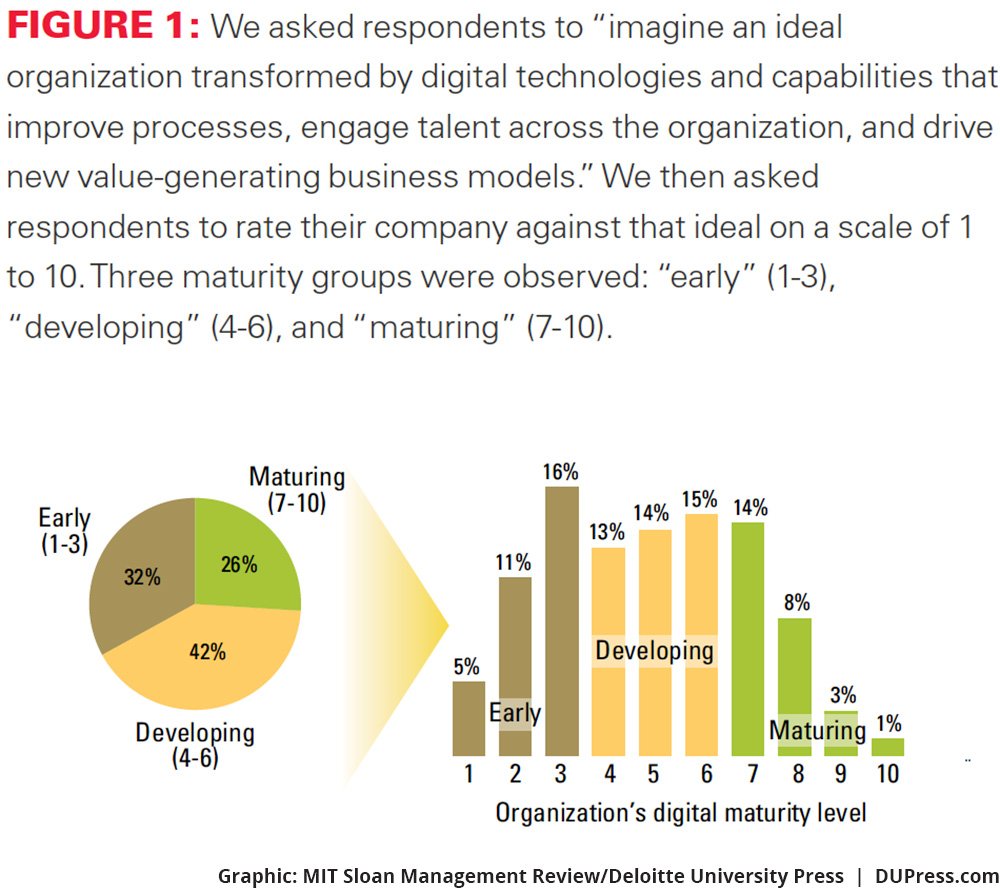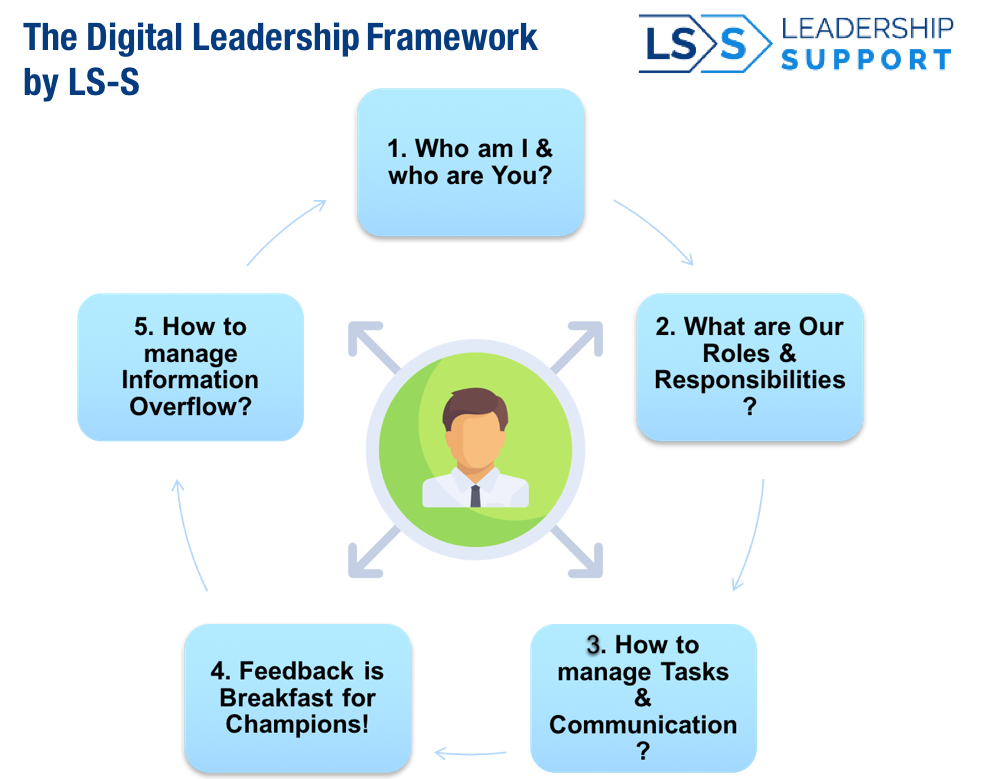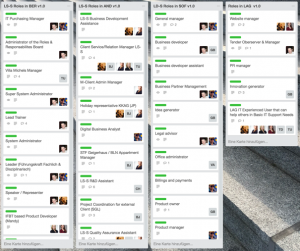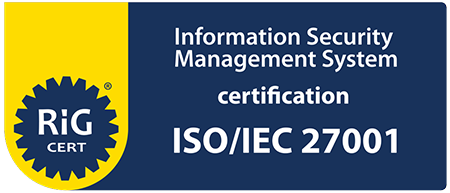0. Intro: What is Digital Leadership? While there are many ways to approach digital transformation in a company, current research has shown that most companies do not feel up to the challenges posed by digitalization.

The overarching goal for any company remains profitability and competitiveness. In order to do so, numerous companies have mobilized manpower and capital to force “digital” into their daily business. The success rates of such undirected incentives, however, remain scanty. It is often forgotten, that a business should also provide a good working environment for its employees and equip them with the right tools to properly contribute to the success of the company. Instead of being “digital” and “innovative” for the sake of the buzzwords, the focus should be on making use of digital means and integrating them into their business operations – slow and steady. To drive this transition a holistic view is key.
The following 5 pillars of the Digital Leadership Framework show you how that is done:
1. Who am I and who are you?
Start off with getting to know yourself and your team, and reflecting on the character traits as well as on how they influence your work. How do you interact with others, and vice versa? What kind of tasks do you enjoy, and which working routine suites you and your team the best? In order to find answers to all these questions and finding a solution that will benefit the entire team, you will need to learn about their personalities and career desires. A self- assessment tool to learn about your personality is the Myers-Briggs Type Indicator (MBTI). A tip for increasing understanding and prevent conflict is to note down the results of your team. This can serve as a reminder of the differences between the 16 personality types. Thereby, you get to keep in mind, that nobody has a malicious agenda or is intentionally misunderstands another person. There are simply different personality traits that shape people’s thinking and interactions. While this seems logical, a graphic illustration and reminder, can be of major assistance in tense situations.

Another answer to the “Who am I” question is the Team Preference questionnaire. This tool illustrates which role in a team you are most comfortable with, and what kind of work you personally prefer. The final results illustrate a rating for all 8 roles, and offer a starting ground for the distribution of roles and responsibilities, when everybody’s team preferences are known.
2. Understanding your Responsibilities
The good old days of clearly defined work descriptions and rigid organizational charts is over. Companies like Cisco have set the example, by creating a corporate structure overview focused on social relations and interactions – A Network of Teams. This kind of flexibility when it comes to positions and hierarchy frequently goes hand in hand with bending options for job positions. Like numerous Silicon & Berlin Valley businesses, LS-S is using a Trello Board to capture roles and responsibilities. If you seek to be agile you can remain flexible and adaptable to changes by keeping the defined roles and responsibilities simple. Another real perk of having a digital overview is the transparency for every employee. You are looking for the person in charge of for example New Business Development? Simply search for it on the board, and find the person you need to approach. This facilitates the awareness of colleagues and what they really do, – because honestly, who can keep track?

_ Another major perk is the option to update the board easily, adapt roles, and just add new cards (as Trello likes to call them). Opportunities for engaging your team and allowing them to consciously internalize “their dominion” is to let them define new tasks and updates together with you as a leader. Maintaining the same procedure for updates and the definition of new roles contributes to an atmosphere of appreciation and inclusion.
3. Clearly Define Communication Channels
Communication, especially in today’s environment of high-speed information transmission poses one of the major challenges for corporate management. There are two crucial issues to consider, before going into the fine-tuning. Firstly, limiting communication channels. Especially, when it comes to teams that are spread across numerous countries, choosing the right channels and allowing your employees to directly get in touch with one another makes the work relationships more personal, in spite of distance. Many companies seeking consultation from LS-S, stress the struggle of choosing the right channel, and limiting the number of channels. The aim is hereby, to avoid long searches for information in Slack, Email, skype, your work management software, and all the other useful apps one may have. The criteria for channel selection differ from company to company, depending on internal priorities.
The second issue is the restriction of content, in order to focus on the relevant information for your work. This is directly linked to pillar 5, on the management of information overflow Link
4. Feedback is Breakfast for Champions!
Open discussions with your team members, on what is going well – and what is not – are truly useful. Once you have created a working culture of open communication, you will notice the advantages in driving your cause forwards. There are a variety of interpersonal hurdles that can get in the way of honest feedback, though. That is why companies should also consider implementing 360° feedbacks into their HRD efforts. The 360° Feedback combines feedback from superiors, employees, colleagues, and sometimes even clients into an apprehensible report, while ensuring anonymity.
With 360° Feedbacks, you can certainly go for the standard surveys available from numerous providers to get superficial insights, however, the experience of companies like Roche and Liebherr has shown, that they can look back at improved performance and employee relations, due to a tailor-made survey reflecting on the corporate competency model, and wrapping it all up with a personal debriefing, done by a certified expert. The recommendation would therefore be to do it right, and invest more effort for the benefit of in-depth feedback.
Feedback towards the organisational aspects like workflows or roles&responsibilities also needs to be facilitated to improve the collaboration internally (team & department level) and externally (percieved qualitiy of service & delivery by the clients). By default agile working teams do the monthly “kaizen-meetings”. Kaizen is Japanese and means “change for better”. Ideally, such a meeting would take place on a regular basis, and ask employees for recommendations for improving the working environment as well as the current modus operandi.
5. Managing Information OverflowThe digital age comes with waves of information, out of which leaders have to find the relevant pieces for their work. Establishing a content restricting policy for the sharing of information, and selecting an interface where documents are shared, and where modifications, updates, and newest versions are clearly distinguishable is always the first step. Jira for example allows for the tracking document development in relation to a specific project or lead. By now, countless other software providers have developed their alternatives. In addition to the task-tracking, there are numerous apps that assist a leader in sharing their information. LS-S itself has developed ActExs as a document editing and sharing App, as well as the Project indicator, which asks the relevant questions to each stakeholder group involved, in order to received solely the KPIs, no additional chit-chat.
In Conclusion
All five pillars are interconnected, and allow for a digital approach to leadership. Creating a guiding principle for yourself, on how to empower your employees is crucial for a successful team, unit, and ultimately a successful business. Once you introduce your employees to digital tools with a personal advantage and direct usability they are likely to accept the “digital”. Successful digitalization, and digital affinity are, however, the result of a of steady familiarization and practice, that will require a leader’s guidance.




